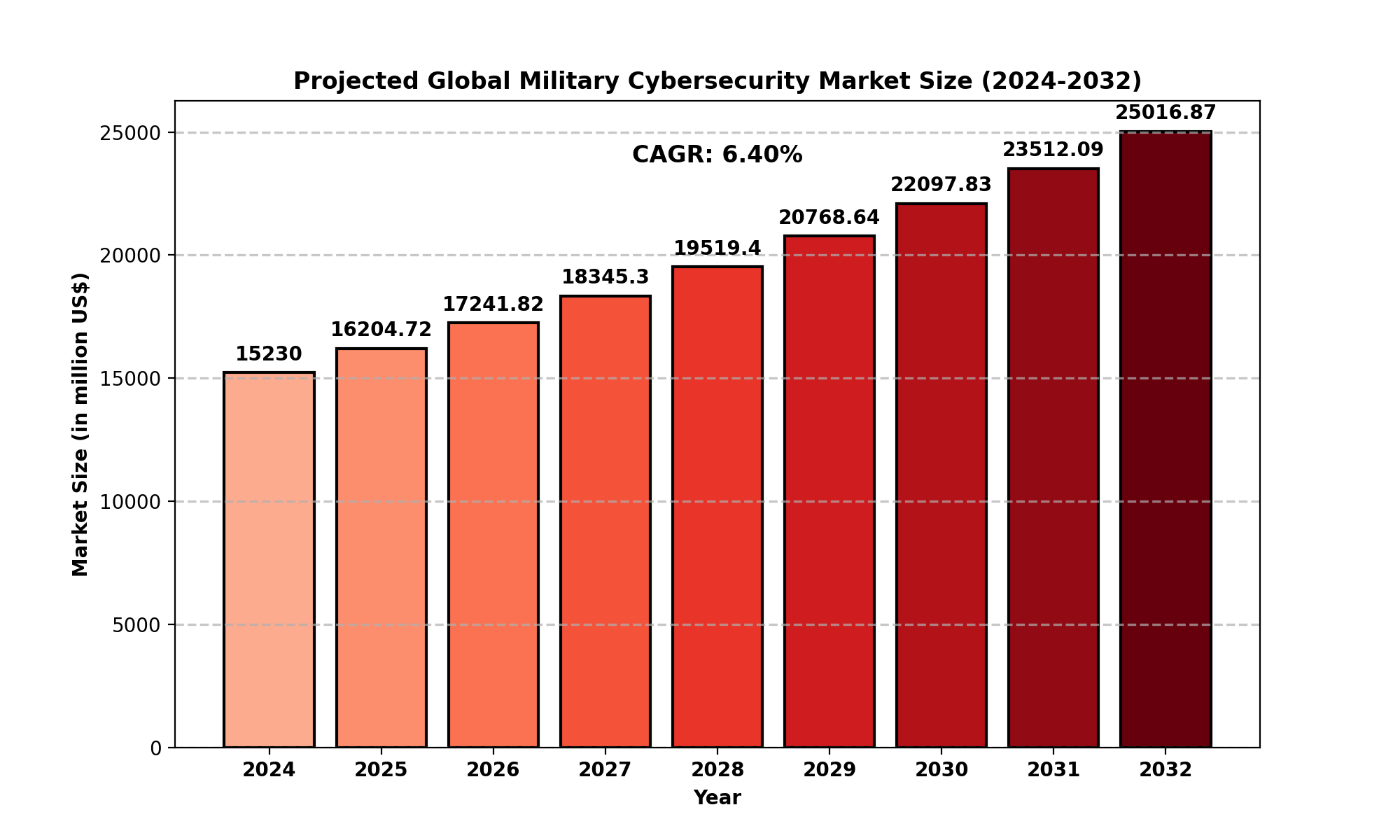TOP CATEGORY: Chemicals & Materials | Life Sciences | Banking & Finance | ICT Media

Download Report PDF Instantly
Report overview
Military cybersecurity refers to the measures and technologies implemented by military organizations to protect their computer systems, networks, and data from various threats. This includes both preventive measures and active defense strategies aimed at securing hardware, software, and sensitive data against malicious and accidental breaches. Cybersecurity in the military context is vital to ensuring that critical information remains secure while maintaining the continuous operation of defense systems. The scope of military cybersecurity covers defense against cyber-attacks, protecting military assets, and ensuring the safety of classified and operational information.
In essence, military cybersecurity serves as the backbone of national defense strategies, protecting against espionage, sabotage, and other forms of cyber warfare. The overall goal is to ensure the secure and uninterrupted functioning of military communication systems, operational data, and national security infrastructure.
Market Size
The global military cybersecurity market was valued at approximately USD 15,230 million in 2024. It is expected to experience significant growth, with projections reaching USD 25,016.87 million by 2032. This represents a Compound Annual Growth Rate (CAGR) of 6.40% during the forecast period.
In terms of regional distribution, North America holds a dominant share of the global market. The North American military cybersecurity market was estimated at USD 4,415.85 million in 2024, and it is expected to expand at a CAGR of 5.49% from 2025 through 2032.
The growth of this market can be attributed to increasing cyber threats and attacks on national security infrastructures, the growing dependence on digital technologies for military operations, and the rising need for comprehensive defense mechanisms to counteract cyber warfare. Moreover, advancements in technology, such as artificial intelligence (AI), machine learning, and blockchain, are further boosting the demand for military cybersecurity solutions.

Market Dynamics
Drivers
Several factors are driving the growth of the military cybersecurity market:
Rising Cyber Threats: With increasing global political tensions and military conflicts, cyber-attacks targeting critical infrastructure and national security assets are becoming more prevalent. Countries are investing in military cybersecurity to counter such threats.
Technological Advancements: The continuous development of AI, machine learning, and other advanced technologies is enabling military organizations to create more sophisticated defense systems against evolving cyber threats.
Digitalization of Military Systems: As military systems become more digitized and interconnected, the need for robust cybersecurity mechanisms increases. Modern defense platforms rely heavily on digital systems, making them vulnerable to cyber-attacks.
Government Regulations and Initiatives: Governments worldwide are increasingly mandating the adoption of enhanced cybersecurity measures within their military and defense sectors to protect national security.
Increase in Military Budgets: Countries are allocating more resources to defense cybersecurity in response to growing cyber threats, contributing to market growth.
Restraints
Despite its growth, the military cybersecurity market faces several challenges:
High Costs: Developing, implementing, and maintaining cybersecurity solutions can be expensive. The high costs of advanced technologies such as AI-driven cybersecurity systems may limit adoption among some countries.
Complexity of Integration: Integrating new cybersecurity technologies with legacy systems can be challenging. Military organizations often face difficulties in ensuring compatibility and seamless operation across diverse systems.
Shortage of Skilled Personnel: There is a global shortage of cybersecurity experts, including those with specialized knowledge of military networks and systems. This lack of skilled personnel can slow down the implementation of robust cybersecurity measures.
Opportunities
The military cybersecurity market offers several untapped opportunities:
Emerging Markets: Countries in the Asia-Pacific region, especially China and India, are increasing investments in cybersecurity solutions to enhance their military capabilities. These emerging markets present lucrative growth opportunities.
Automation and AI: The adoption of AI-driven cybersecurity solutions presents an opportunity to develop more proactive defense mechanisms. Automated systems that can detect and neutralize threats in real-time are in high demand.
Cloud Security Solutions: As more military organizations adopt cloud-based platforms, there is an increasing need for advanced cloud security measures. This offers opportunities for cybersecurity providers to develop specialized solutions for military applications.
Challenges
The military cybersecurity market also faces several challenges:
Evolving Threat Landscape: Cyber threats are constantly evolving, with adversaries using increasingly sophisticated methods. Military cybersecurity systems must continuously adapt to these new tactics, techniques, and procedures.
Coordination Among Stakeholders: Effective cybersecurity requires collaboration between various military branches, government agencies, and private sector companies. Coordination among these stakeholders can be difficult, hindering the timely implementation of cybersecurity measures.
Global Cyber Warfare: The increasing frequency of cyber warfare is a major challenge. State-sponsored cyber-attacks targeting military infrastructure can be difficult to counter and can have widespread implications for national security.
Regional Analysis
North America
North America, particularly the United States, dominates the military cybersecurity market. The region benefits from high defense budgets, advanced technological infrastructure, and a strong emphasis on cybersecurity in the military. The increasing number of cyber-attacks targeting military assets is a major driver of growth in this region.
Europe
Europe is another significant market for military cybersecurity solutions. Countries like the UK, France, and Germany are major players, investing heavily in securing their defense systems. With growing concerns over cyber threats from Russia and other geopolitical tensions, the demand for military cybersecurity is expected to rise.
Asia-Pacific
The Asia-Pacific region is witnessing rapid growth in military cybersecurity. Countries like China, Japan, and India are ramping up their cybersecurity efforts as part of broader defense modernization programs. The region's large military budgets and growing cyber threat landscape contribute to the increasing adoption of military cybersecurity solutions.
South America
In South America, countries such as Brazil and Argentina are beginning to invest more in military cybersecurity as they recognize the increasing need for secure defense systems. However, the region lags behind in terms of overall market size compared to North America and Europe.
Middle East and Africa
The Middle East and Africa (MEA) region presents emerging opportunities for the military cybersecurity market, driven by regional security challenges and the growing use of digital technologies in defense operations. Countries like Saudi Arabia, the UAE, and South Africa are leading the way in military cybersecurity adoption.
Competitor Analysis
Key players in the military cybersecurity market include:
Lockheed Martin – A leading defense contractor known for its advanced military cybersecurity solutions.
BAE Systems – A prominent player with expertise in cybersecurity for defense applications.
Raytheon – Known for its cybersecurity solutions for defense and government sectors.
Northrop Grumman – Offers advanced cybersecurity services to protect military systems.
Thales – A global leader in providing cybersecurity solutions for defense and aerospace.
Booz Allen Hamilton – Specializes in cybersecurity services for the government and defense sectors.
ManTech – Provides cybersecurity solutions for national security and defense organizations.
Cisco Systems – Offers a range of cybersecurity products for military and government agencies.
SAIC – Known for its cybersecurity services and technology solutions for the defense sector.
General Dynamics – Delivers innovative cybersecurity solutions for military clients.
L3Harris Technologies – A key player in providing cybersecurity services to the defense industry.
Boeing – Known for its defense solutions, including advanced cybersecurity technologies.
IBM – Offers robust cybersecurity solutions with a focus on military applications.
Leidos – A leader in providing cybersecurity solutions for national defense organizations.
Global Military Cybersecurity: Market Segmentation Analysis
This report provides a deep insight into the global Military Cybersecurity market, covering all its essential aspects. This ranges from a macro overview of the market to micro details of the market size, competitive landscape, development trend, niche market, key market drivers and challenges, SWOT analysis, value chain analysis, etc.
The analysis helps the reader to shape the competition within the industries and strategies for the competitive environment to enhance the potential profit. Furthermore, it provides a simple framework for evaluating and assessing the position of the business organization. The report structure also focuses on the competitive landscape of the Global Military Cybersecurity Market. This report introduces in detail the market share, market performance, product situation, operation situation, etc., of the main players, which helps the readers in the industry to identify the main competitors and deeply understand the competition pattern of the market.
In a word, this report is a must-read for industry players, investors, researchers, consultants, business strategists, and all those who have any kind of stake or are planning to foray into the Military Cybersecurity market in any manner.
Market Segmentation (by Application)
Ground Force
Air Force
Marine Force
Market Segmentation (by Type)
Defensive Cybersecurity
Offensive Cybersecurity
Key Company
Lockheed Martin
BAE Systems
Raytheon
Northrop Grumman
Thales
Booz Allen Hamilton
ManTech
Cisco Systems
SAIC
General Dynamics
L3Harris Technologies
Boeing
IBM
Leidos
Geographic Segmentation
North America (USA, Canada, Mexico)
Europe (Germany, UK, France, Russia, Italy, Rest of Europe)
Asia-Pacific (China, Japan, South Korea, India, Southeast Asia, Rest of Asia-Pacific)
South America (Brazil, Argentina, Columbia, Rest of South America)
The Middle East and Africa (Saudi Arabia, UAE, Egypt, Nigeria, South Africa, Rest of MEA)
FAQ
What is the current market size of Military Cybersecurity?
Which are the key companies operating in the Military Cybersecurity market?
What are the key growth drivers in the Military Cybersecurity market?
Which regions dominate the Military Cybersecurity market?
What are the emerging trends in the Military Cybersecurity market?
Key Benefits of This Market Research:
Key Reasons to Buy this Report: